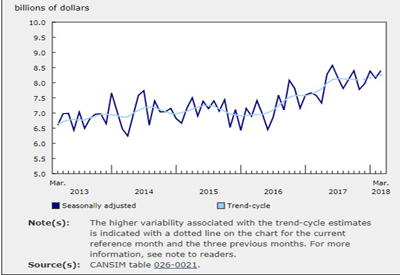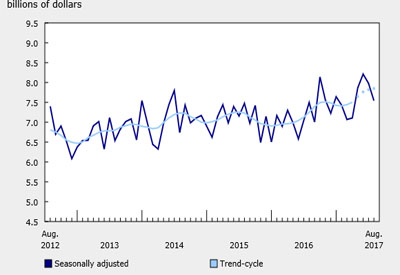Labour Force Survey, September 2022

October 17, 2022
Employment was little changed in September. The unemployment rate fell 0.2 percentage points to 5.2% as fewer people searched for work.
Employment declined for a second consecutive month among young women aged 15 to 24, but increased among male youth and core-aged women (25 to 54 years) in September.
Gains in educational services and health care and social assistance were offset by losses in manufacturing; information, culture and recreation; transportation and warehousing and public administration.
The number of employees in the public sector rose in September, partially offsetting declines recorded in July and August. Employment was little changed among employees in the private sector and among self-employed workers.
Employment increased in four provinces, led by British Columbia, while there were fewer people working in Ontario and Prince Edward Island.
Year-over-year wage growth remained above 5% for a fourth consecutive month, with the average hourly wages of employees rising 5.2% (+$1.57 to $31.67) compared with September 2021 (not seasonally adjusted).
Total hours worked were down 0.6% in September 2022. Despite declining by 1.1% since June, total hours worked were up 2.4% on a year-over-year basis.
In September, there were just under one million (983,000; 57.5%) people aged 55 to 64 who cited retirement as their main activity.
While the employment rate among core-aged mothers was at a record high in September, those with a child under 16 were twice as likely (14.9%) to have decided not to apply for a job or a promotion over the previous 12 months than their male counterparts (7.1%).
Employment little changed in September
After dropping in August, employment was little changed (+21,000) in September, with both full-time and part-time work holding steady. Compared with May 2022—when employment last increased—there were 92,000 (-0.5%) fewer people working in September.
Among core-aged population, employment rises for women, holds steady for men
Employment among women aged 25 to 54 grew by 47,000 (+0.8%) in September, the first increase since May 2022, with all the gains being in full-time work. Compared with 12 months earlier, employment among core-aged women was up by 174,000 (+2.9%) in September. Year-over-year employment increases were spread across several industries, including manufacturing (+32,000); professional, scientific and technical services (+25,000); and transportation and warehousing (+24,000) (not seasonally adjusted).
Employment among core-aged men was unchanged for a fifth consecutive month in September, but was up by 188,000 (+2.9%) on a year-over-year basis.
The employment rate for core-aged workers as a whole held steady at 84.2% in September.
Across racialized groups, the employment rate ranged from 72.3% among Latin American Canadians to 87.9% among Filipino Canadians. Among Indigenous populations, the employment rate was 71.2% for First Nations people living off-reserve and 81.8% for Métis in September (three-month moving averages, not seasonally adjusted).
Employment decreases among young women, little changed for older workers
Employment among youth aged 15 to 24 fell by 26,000 (-1.0%) in September. The decrease was driven by young women (-40,000; -3.1%), who saw employment declines for a second consecutive month.
After remaining virtually unchanged since February 2022, employment rose by 14,000 (+1.1%) for young men in September, driven primarily by those aged 20 to 24.
Among Canadians aged 55 and older, both total employment and the employment rate were little changed for a third consecutive month.
Employment rebounds in the public sector, boosted by educational services
After declining for two consecutive months, the number of employees in the public sector increased by 35,000 (+0.8%) in September. Most of the gain was attributable to the educational services industry, which accounts for close to one-third (30.4%) of employees in the public sector (not seasonally adjusted).
The number of private sector employees was little changed in September. Despite seeing little growth since June, the number of private sector employees was up 316,000 on a year-over-year basis, and accounted for close to three-quarters (72.8%) of the net increase in the number of employees (+434,000) over the past 12 months.
Self-employment was little changed in September on both a monthly and year-over-year basis. The number of self-employed workers has yet to return to its pre-COVID-19 pandemic level and was down by 244,000 (-8.5%) compared with February 2020.
Since September 2019, self-employment has declined notably in construction (-52,000; -12.0%) and “other services” (-59,000; -23.5%), which includes personal and repair services, as well as civic and religious organizations (not seasonally adjusted).
Average hourly wages increase 5.2% on a year-over-year basis
Year-over-year growth in the average hourly wages of employees surpassed 5% for a fourth consecutive month in September (+5.2%; +$1.57 to $31.67) (not seasonally adjusted). In comparison, year-over-year growth in the Consumer Price Index (CPI) was at, or above, 7.0% from May to August.
Average hourly wages were up in nearly all industries on a year-over-year basis in September, including in accommodation and food services (+8.7%; +$1.51 to $18.89). In this industry, average wages of employees were up 13.2% in Ontario (+$2.27 to $19.51) and 8.1% in Quebec (+$1.41 to $18.81), two provinces where the minimum wage for employees who receive tips was increased in 2022. Average wages in the industry were little changed in Nova Scotia, Manitoba, Saskatchewan and Alberta on a year-over-year basis (not seasonally adjusted).
Gains in average hourly wages are the result of multiple factors, including wage growth and changes in the composition of employment by industry and occupation. In September, wage gains were boosted by year-over year growth in the number of employees in relatively high-paying industries, including construction (+109,000; +10.0%) and professional, scientific and technical services (+56,000; +4.4%). Average wages were up 7.5% (+$2.36 to $33.79) in construction and 9.1% in professional, scientific and technical services (+$3.42 to $40.98) in September, with gains in the latter industry exceeding 7% in six provinces (not seasonally adjusted).
Fewer people worked from home in September
The proportion of workers who report that they usually work exclusively at home fell slightly from 16.8% in August to 16.3% in September. The share of workers with hybrid arrangements—that is, who usually work both at home and in a location other than home—was unchanged in September, at 8.6% (population aged 15 to 69, not seasonally adjusted).
While there was little change in the indicators of usual work location, two measures of where people worked during the Labour Force Survey (LFS) reference week—regardless of their usual arrangement—suggest that workers and employers may be continuing to adapt and adjust where work is done. First, the proportion of employed Canadians who worked exclusively at home during the LFS reference week was lower in September (13.8%) than in August (15.3%). Second, the proportion of workers who worked a mix of hours at home and elsewhere increased 0.9 percentage points to 20.5% over that same period (population aged 15 to 69, not seasonally adjusted).
After increasing in August, unemployment rate declines in September
The number of unemployed Canadians fell 41,000 (-3.7%) in September. After increasing 0.5 percentage points to 5.4% in August, the unemployment rate dropped to 5.2%. The adjusted unemployment rate—which includes people who wanted a job but did not look for one—was little changed.
Unemployment rate down among core-aged and older women
For women, the unemployment rate fell for those aged 55 and older (-0.5 percentage points to 4.7%) and those aged 25 to 54 (-0.2 percentage points to 4.3%) in September. The unemployment rate among female youth (8.8%) aged 15 to 24 was little changed for a second consecutive month.
The unemployment rate was little changed among men in each of the major age groups in September. Among both male youth (10.8%) and core-aged men (4.5%), the rate held steady after increasing in August. Among men aged 55 and older, the rate (4.6%) was little changed for a fourth consecutive month.
In September, the unemployment rate ranged from 4.2% among Japanese Canadians to 9.8% among West Asian Canadians and 10.7% among Latin American Canadians (three-month moving averages, not seasonally adjusted).
Fewer Canadians in unemployment for 27 weeks or more
Long-term unemployment—the number of people who had been continuously unemployed for 27 weeks or more—declined by 18,000 (-9.7%) in September, offsetting the increase in August (+22,000; +13.7%). Long-term unemployment first returned to its February 2020 level in June 2022 and has hovered around a similar level in recent months. Long-term unemployment expressed as a proportion of the total labour force was 0.8% in September, slightly lower than what it was before the pandemic in February 2020 (0.9%).
Labour force shrinks over the summer of 2022
The supply of labour has been a particularly important aspect of the labour market over the past year, in the context of record-high job vacancies earlier in 2022, as well as the longer-term issue of population aging. While elevated job vacancies continued until at least July, both the total size of the labour force—or the number of people who are either employed or unemployed—as well as the participation rate have trended downwards since May. Specifically, the total labour force was down by 79,000 (-0.4%) compared with May, although it was little changed on a monthly basis in September. The labour force participation rate edged down by 0.1 percentage points from August to 64.7% in September, and was 0.6 percentage points lower than in May.
Among young women aged 15 to 24, the participation rate declined 2.1 percentage points to 63.1% in September, falling below its pre-pandemic February 2020 level for the first time since June 2021. The participation rate among male youth (63.8%) was little changed for a second consecutive month in September and remained on par with its pre-pandemic level.
Among women aged 25 to 54, the participation rate was up 0.4 percentage points in September to 84.8%, on par with the record high of 85.0% seen in May 2022. Among core-aged men, the participation rate fell 0.3 percentage points to 91.4% in September, continuing a downward trend from its recent peak of 92.3% recorded in March 2022.
The participation of those aged 55 and older was 36.1% in September, little changed from August. Specifically, among those aged 55 to 64, the participation rate was up 0.4 percentage points in September to 66.4%. Despite this monthly increase, the participation rates of both men and women aged 55 to 64 trended down from the fall of 2021 to June 2022 and remained below their respective February 2020 levels in September 2022.
Employment gains in educational services and health care and social assistance offset by drop in manufacturing
The number of people working in educational services rose by 46,000 (+3.2%) in September, largely offsetting the decline of 50,000 (-3.3%) recorded in August. Increases in this industry were observed in six provinces, led by Ontario (+17,000; +3.1%) and British Columbia (+12,000; +6.3%). On a year-over-year basis, employment in the industry was little changed.
There was also a rise in the number of people working in health care and social assistance (+24,000; +0.9%) in September, the first increase in seven months. According to the latest results from the Job Vacancy and Wage Survey, there were 143,000 vacant positions in health care and social assistance in July 2022, little changed from the record high observed in March 2022 (148,000). While employment in the industry was up by 48,000 (+1.9%) on a year-over-year basis in September, total hours worked were little changed compared with September 2021. At the same time, the proportion of workers in the industry who were absent due to illness or disability for at least part of the week was up by 1.1 percentage points on a year-over-year basis, to 8.2% (not seasonally adjusted).
The number of people working in manufacturing decreased by 28,000 (-1.6%) in September, bringing employment in the industry back down to the level last recorded in May 2022. The majority of the decline occurred in Ontario (-19,000; -2.4%), followed by British Columbia (-5,900; -3.4%). According to the latest data from the Monthly Survey of Manufacturing, manufacturing sales decreased for a third consecutive month in July.
Employment in information, culture and recreation also posted a decrease in September (-22,000; -2.6%). While the number of people working in the industry had hovered above pre-COVID-19 February 2020 levels since February 2022, the September decline brought employment in the industry back down to its pre-pandemic level.
Employment declines were also recorded in transportation and warehousing (-18,000; -1.8%) and public administration (-12,000; -1.0%) in September.
Employment up in four provinces in September
Employment increased in British Columbia, Manitoba, Nova Scotia and New Brunswick in September. In contrast, fewer people worked in Ontario and Prince Edward Island. On a year-over-year basis, employment was up in all provinces. For further information on key province and industry level labour market indicators, see “Labour Force Survey in brief: Interactive app.”
Employment in British Columbia increased by 33,000 (+1.2%) in September, offsetting a decrease of 28,000 in August. The unemployment rate declined to 4.3% (-0.5 percentage points). Employment gains in September were led by the educational services, and the professional, scientific, and technical services industries. In the Vancouver census metropolitan area (CMA), employment increased by 28,000 (+1.8%) and the unemployment rate was 3.9%.
In Manitoba, employment increased by 6,900 (+1.0%) in September, partly offsetting a decline of 10,000 in August. The unemployment rate fell 0.8 percentage points to 4.5%. The Winnipeg CMA saw little change in employment, while the unemployment rate rose 0.3 percentage points to 4.6% (three-month moving average).
Following a decline in July and little change in August, employment decreased by 32,000 (-0.4%) in Ontario in September. With fewer people participating in the labour force, the unemployment rate was little changed at 5.8%. Industries with employment losses included manufacturing; professional, scientific and technical services; and wholesale and retail trade. In contrast, more Ontarians were employed in educational and in business, building and other support services.
In the Toronto CMA, employment decreased by 66,000 (-1.9%) in September and the unemployment rate rose 0.4 percentage points to 6.3%. On a three-month moving average basis, the unemployment rate ranged from a high of 8.6% in the CMA of Windsor to a low of 3.9% in the Guelph CMA.
Following an increase in August, employment held steady in Quebec in September and the unemployment rate (4.4%) was little changed.
In Atlantic Canada, employment increased in Nova Scotia (+4,300; +0.9%) and New Brunswick (+2,900; +0.8%) in September, while it fell in Prince Edward Island (-3,800; -4.4%). Post-tropical storm Fiona struck the Atlantic provinces and the Eastern Quebec region of Gaspésie-Magdalen Islands on September 23, after the LFS reference week.
Quarterly update for the territories
Following gains in the first quarter of 2022 and little change in the second quarter, employment in the Northwest Territories fell by 600 (-2.4%) in the third quarter. At 4.3%, the unemployment rate was little changed in the three months ending in September.
Employment in Yukon held steady in the third quarter after an increase in the second quarter, and the unemployment rate remained at 2.5%.
Employment in Nunavut held steady in the third quarter and the employment rate was 55.4%. The unemployment rate was 12.0% in the three months ending in September, little changed from the second quarter (three-month average ending in June).
In the Spotlight: Retirement before age 65, and parents in the labour force
Nearly one million people aged 55 to 64 cite retirement as main activity
Over the past 20 years, total labour force participation—that is, the proportion of the population aged 15 and older that is either employed or unemployed—has fallen slowly but steadily from 67.1% in September 2002 to 64.7% in September 2022. This decline has been due in large part to population aging, as ongoing retirements among the baby boom cohort puts downward pressure on labour supply in Canada. Since September 2019, for example, the number of Canadians aged 65 and older has increased 11.6% (+736,000), compared with working-age population growth of 3.5%.
To shed additional light on factors influencing labour force participation, in March 2020 the LFS began collecting information on the main activity of those who are neither employed nor unemployed, and who indicate that they do not currently want a job. In the coming months and years, this new information will be an important complement to trends in labour force participation among various population groups, including those approaching retirement age.
As of September, there were 5.2 million Canadians aged 55 to 64, and two-thirds (66.8%) were either employed or unemployed. Of the remaining 1.7 million who were not participating in the labour market, just under one million (983,000; 57.5%) cited retirement as their main activity. Illustrating the contribution of aging and retirements to current labour supply, 146,000 of these retirees had worked within the last year, including 24,000 whose last job was in educational services and 22,000 who had recently left a job in health care and social assistance (not seasonally adjusted).
In addition to those who report retirement as their main activity, about one-fifth (19.6%; 335,000) of 55-to-64-year-olds reported in September that they were not in the labour market due to illness or disability, while just over one in ten (11.4%; 195,300) indicated they were doing household work. The remaining 196,000 (11.5%) cited some other main activity, including caring for family, travelling, volunteering, or “other” activities (not seasonally adjusted).
Childcare responsibilities have had more influence on the career decisions of women than men over the past year
For many parents, the COVID-19 pandemic brought notable disruptions to the balance between work and family life. Mothers and fathers across Canada had to contend with the temporary closure of schools and daycares, while those working from home also needed to adapt by finding new ways of managing childcare responsibilities with work calls and virtual meetings. Yet, with the easing of public health restrictions in the summer of 2021, the employment rate of both mothers and fathers aged 25 to 54 surpassed pre-COVID-19 levels in the fall of 2021.
In September 2022, with most COVID-19-related public health measures lifted and as parents and children started to settle back into the school routine, the employment rate of core-age mothers with at least one child under 18 was 79.9%, its highest level for the month of September since 1976, and up 2.1 percentage points compared with September 2019. The employment rate of fathers in the same age group was 93.5%, the highest level for the month of September since 1981 (not seasonally adjusted).
Partly reflecting long-standing differences across population groups, the employment rate among core-aged mothers ranged from 54.4% among Korean women and 56.8% among Latin American women to 81.5% among Filipino women (three-month moving averages, not seasonally adjusted).
Despite their record-high employment rate, women were more likely than men to have taken career or job-related decisions that prioritized childcare responsibilities. In September 2022, according to new data from the LFS focusing on parents with children under 16, core-aged mothers with a child under 16 were twice as likely (14.9%) to have decided not to apply for a job or a promotion over the previous 12 months than their male counterparts (7.1%). In addition, 7.6% of mothers turned down a job offer over the previous year due to childcare responsibilities, compared with 4.0% of fathers (not seasonally adjusted).
Mothers also continue to take on more tasks related to schooling than their male counterparts. In September, nearly half (48.5%) of core-aged mothers with children under 16 indicated that they helped their children with homework and homeschooling most of the time or all of the time, compared with one-quarter (24.3%) of their male counterparts (not seasonally adjusted).











